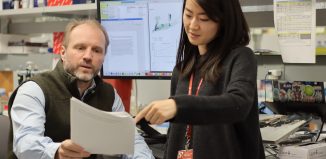CSHL’s Krainer tackles spinal muscular atrophy
Emily Krainer can hear the excitement in her father’s voice when she calls. After she gets off the phone, she tells her classmates about his work, which, one day, could influence their lives. Like Emily, they attend Vanderbilt University School of Medicine and, once they graduate, may use his work to help their patients.
The younger Krainer has “high hopes” for a promising new treatment her father developed for a potentially fatal disease.
Adrian Krainer, a professor and program chair of Cancer and Molecular Biology at Cold Spring Harbor Laboratory, has developed a drug for a pediatric neurological condition called spinal muscular atrophy, which is the leading genetic case of death among infants and affects about 1 in 6,000 newborns.
The drug, called an antisense oligonucleotide, is in phase III trials, which is the final stage before the Food and Drug Administration considers approving it.
SMA is a genetic disorder caused by a defective SMN1 gene. Patients with SMA rely on the SMN2 gene, which can produce normal survival of motor neuron protein but in low quantities because alternative splicing results in a shorter, unstable form of the protein.
Splicing is the process where important genetic information, exons, are joined together, while less important genetic parts, introns, are removed. The process starts with an RNA that is a copy of the gene, Krainer explained. For the SMN2 RNA, splicing leaves out the next to last exon. Krainer has found a way to encourage the splicing machinery to include exon 7 more efficiently.
These phase III trials involve two separate groups of patients. The first includes infants with type 1 SMA, which is the most severe version and has an average life expectancy of two years. Working with Isis Pharmaceuticals in California, doctors in these clinical trials will determine if the drug increases survival and reduces the need for ventilation.
In the second group, patients who are from two years of age up to 14 with type 2 SMA, which is an intermediate form of the disease, will receive the drug. Doctors will monitor improvements in neuromuscular function, Krainer said.
His Ph.D. advisor at Harvard, Tom Maniatis, praised his former student.
“This is beautiful and highly original work, which has already shown great promise for SMA therapy,” explained Maniatis, who is now chairman of the Department of Biochemistry and Molecular Biophysics at Columbia University Medical Center.
While Krainer is awaiting results of these trials, he is making new discoveries that may also affect future treatments.
In mouse models of SMA, Krainer has found that injecting the drug under the skin was even more effective than inserting it directly into the spinal chord.
Additionally, neutralizing the drug in the central nervous system didn’t prevent its effectiveness. The drug enabled spinal chord motor neurons to continue to function, even when it wasn’t active in that area.
“Surprisingly, the effect of the drug given that way is still dramatic,” he said.
Krainer cautioned that results in mice may not display a similar pattern in humans.
Still, the mouse data suggest treatment with this drug might be more effective if administered beneath the skin.
If this drug becomes an accepted treatment for SMA, the approach of creating a synthetic antisense oligonucleotide could also become an effective weapon against other diseases, such as familial dysautonomi, in which a mutation causes a reduction in the expression of a protein.
“It is estimated that 10 to 15 percent of all human disease causing mutations affect RNA splicing, so the tool [Krainer] has developed should have wide applications,” Maniatis suggested.
Maniatis has seen firsthand how Krainer has “a deep passion for science and a strong work ethic. More importantly, in my view, he has an incisive critical mind, which leads to the development of novel approaches and rigorous science.”
In addition to Emily, Krainer has two sons: Andrew, 22, who is in his last semester at CUNY-Baruch College, and Brian, 20, who is a junior at Carnegie-Mellon.
When she was young, Emily Krainer said she met children with SMA at conferences. These interactions “shaped my interest.”
Emily said her father is a role model and “hopes whatever I do in the future, I enjoy as much as he enjoys his work.”
As for the drug trials, the younger Krainer said her fellow future doctors want to know how this treatment works. She said her classmates hope he is “going to change the lives of so many patients.”






